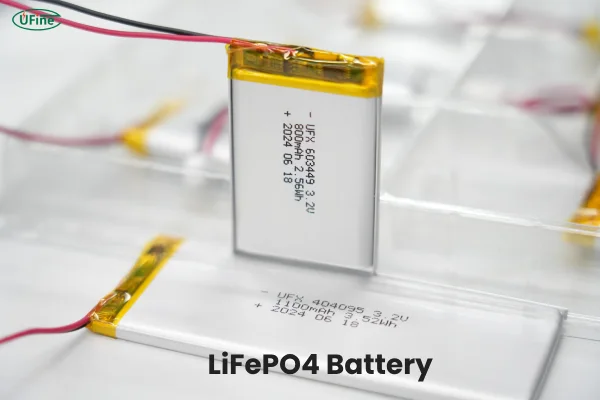
- Part 1. Understanding outdoor lights battery
- Part 2. 6 types of batteries for outdoor lights
- Part 3. Choosing the best outdoor lights battery for your needs
- Part 4. Solar outdoor lights: Battery requirements & optimization
- Part 5. How long will your lights last?
- Part 6. Weatherproofing your outdoor lights battery
- Part 7. Installation & maintenance best practices
- Part 8. Troubleshooting common outdoor light battery issues
- Part 9. Smart outdoor lighting: Battery considerations
- Part 10. Top 5 outdoor lights battery brands compared
- Part 11. FAQs
Part 1. Understanding outdoor lights battery
How Do Outdoor Light Batteries Work?

Outdoor light batteries store energy, either from solar panels or electrical sources, and release it to power the lights during the night. The efficiency of this energy storage and release determines the performance of your outdoor lighting.
Key Components:
- Capacity (mAh or Ah): Indicates how much energy the battery can store.
- Voltage (V): Must match the requirements of your lighting fixture.
- Cycle Life: The number of complete charge and discharge cycles a battery can undergo before its capacity diminishes.
Rechargeable vs. Disposable Batteries
While disposable batteries might seem convenient, rechargeable batteries are more cost-effective and environmentally friendly in the long run. They offer better performance and reduce waste.
Part 2. 6 types of batteries for outdoor lights
1. Lithium-ion (Li-ion) Batteries
- Pros: High energy density, lightweight, and long lifespan.
- Cons: Sensitive to high temperatures and overcharging.
- Best For: Smart lighting systems and areas with moderate climates.
2. Lithium Iron Phosphate (LiFePO4) Batteries
- Pros: Enhanced safety, long cycle life, and stable performance.
- Cons: Higher initial cost.
- Best For: Solar lights and regions with extreme temperatures.
3. Nickel-Metal Hydride (NiMH) Batteries
- Pros: Eco-friendly, good capacity, and less prone to memory effect.
- Cons: Shorter lifespan compared to lithium batteries.
- Best For: Garden lights and moderate usage scenarios.
- Pros: Cost-effective and reliable.
- Cons: Bulky, requires maintenance, and shorter lifespan.
- Best For: Large-scale lighting systems.
5. Alkaline Batteries
- Pros: Widely available and inexpensive.
- Cons: Non-rechargeable and not eco-friendly.
- Best For: Temporary lighting needs.
6. Solar-Specific Batteries
- Pros: Designed for solar charging, efficient energy storage.
- Cons: Performance varies based on sunlight availability.
- Best For: Solar-powered outdoor lights.
Part 3. Choosing the best outdoor lights battery for your needs
Matching Battery Type to Light Fixture
Ensure the battery’s voltage and capacity align with your light fixture’s requirements. Using incompatible batteries can lead to suboptimal performance or damage.
Climate Considerations
- Hot Climates: LiFePO4 batteries perform well in high temperatures.
- Cold Climates: NiMH batteries are more resistant to cold temperatures.
Capacity Requirements Based on Usage
Assess how long you need the lights to operate and choose a battery with sufficient capacity. For instance, for 8 hours of illumination, ensure the battery can support that duration.
Budget vs. Long-Term Value Analysis
While some batteries might be cheaper upfront, investing in high-quality rechargeable batteries can save money over time due to their longevity and performance.
Part 4. Solar outdoor lights: Battery requirements & optimization
Special Battery Needs for Solar Applications
Solar lights require batteries that can efficiently store energy during the day and release it at night. LiFePO4 and NiMH batteries are commonly used due to their stability and efficiency.
Daylight Charging Efficiency Factors
Ensure solar panels are clean and positioned to receive maximum sunlight. Obstructions can reduce charging efficiency.
Winter Performance Considerations
In colder months, battery performance can decline. Choosing batteries designed for low temperatures ensures consistent lighting.
Maximizing Nighttime Runtime
Opt for batteries with higher capacities and ensure solar panels receive adequate sunlight during the day to maximize nighttime illumination.
Part 5. How long will your lights last?
Understanding mAh and Ah Ratings
- mAh (Milliampere-hour): Commonly used for smaller batteries.
- Ah (Ampere-hour): Used for larger batteries.
Higher ratings indicate longer potential runtime.
Runtime Calculation Formulas
Runtime (hours) = Battery Capacity (mAh) / Device Current (mA)Ideal Garden Lights
Real-World Performance Examples
A 2000mAh battery powering a 100mA light can last approximately 20 hours.
Backup Power for Cloudy Days
Consider batteries with higher capacities or integrate backup power sources to ensure consistent lighting during cloudy days.
Part 6. Weatherproofing your outdoor lights battery
Waterproof Battery Enclosures
Use enclosures with high IP ratings to protect batteries from moisture and dust.
Temperature Extremes Management
Select batteries designed to operate efficiently in your region’s temperature range.
Corrosion Prevention Tips
Regularly inspect battery terminals and apply protective coatings to prevent corrosion.
Proper Ventilation Requirements
Ensure battery enclosures have adequate ventilation to dissipate heat and prevent moisture buildup.
Part 7. Installation & maintenance best practices
Correct Battery Orientation
Install batteries as per manufacturer guidelines to ensure optimal performance.
Wiring and Connection Tips
Use appropriate connectors and ensure tight, corrosion-free connections.
Seasonal Maintenance Checklist
- Clean solar panels.
- Inspect battery enclosures.
- Check for corrosion or damage.
Storage Recommendations for Off-Season
Store batteries in a cool, dry place and periodically charge them to maintain health.
Part 8. Troubleshooting common outdoor light battery issues
Diagnosing Quick-Drain Problems
Check for faulty batteries, poor connections, or obstructions blocking solar panels.
Solving Charging Failures
Ensure solar panels are clean and positioned correctly. Inspect charge controllers and connections.
Dealing with Corrosion
Clean terminals with a mixture of baking soda and water. Apply protective coatings to prevent future corrosion.
When to Replace vs. Repair
If batteries consistently underperform despite maintenance, consider replacement. For minor issues, repairs might suffice.
Part 9. Smart outdoor lighting: Battery considerations
Battery Needs for WiFi/Bluetooth Lights
Smart lights often consume more power. Opt for high-capacity batteries to ensure consistent performance.
Motion Sensor Impact on Battery Life
Frequent activations can drain batteries faster. Adjust sensitivity settings to balance performance and battery life.
Automated Lighting Schedules
Program lights to operate during specific hours to conserve battery power.
Integration with Solar Systems
Ensure smart lighting systems are compatible with solar charging setups for efficient energy use.
Part 10. Top 5 outdoor lights battery brands compared
1. Ufine Battery
Ufine Battery can customize lithium batteries of different sizes, voltages, capacities, and discharge rates according to the unique needs of your outdoor lighting systems. Whether you’re powering solar garden lights, motion-sensor security lamps, or advanced smart lighting networks, Ufine offers solutions tailored to ensure optimal performance.
More importantly, they support clients with professional engineering assistance, ensuring the batteries you choose integrate seamlessly into your designs. This level of customization is invaluable—especially when off-the-shelf options just don’t cut it.
Looking for reliable, long-lasting outdoor lights battery solutions?
Don’t hesitate to contact Ufine Battery for personalized lithium battery support: from concept to manufacturing. We’re here to help bring your lighting vision to life.
2. Panasonic
A well-known name in battery technology, Panasonic provides dependable lithium and NiMH options. Their products are often found in high-end solar lighting systems, known for durability and efficiency. However, customization options are limited.
3. Energizer
Energizer is famous for its alkaline and rechargeable batteries. While ideal for smaller or portable outdoor lights, they may not be the best choice for long-term solar systems due to limited cycle life and higher long-term costs.
4. Renogy
Renogy specializes in solar energy products, including battery systems. Their LiFePO4 batteries are a favorite for larger-scale off-grid solar lighting projects. However, their range is less suitable for compact or customized outdoor light fixtures.
5. EBL
EBL provides budget-friendly rechargeable batteries, including NiMH and lithium-ion types. They’re a good starting point for casual users or DIY enthusiasts, though they don’t offer the longevity or support of premium brands like Ufine or Renogy.
Part 11. FAQs
1. How often should I replace my outdoor lights battery?
It depends on the battery type and usage. A quality lithium-ion battery like those from Ufine can last 3–5 years or more. Cheaper batteries may need replacing annually. Always check for reduced brightness or shorter runtimes as early signs of aging.
2. Can I use regular AA batteries for my outdoor lights?
If your lights are designed for AA batteries, yes—but choose rechargeable NiMH or lithium over alkaline for better performance and sustainability. For solar lights, always use the recommended rechargeable type.
3. Why are my solar outdoor lights not turning on at night?
Check if the battery is dead or the solar panel is dirty or shaded. Also, inspect the sensor and wiring. If the battery is old or not holding charge, it may be time to replace it—preferably with a custom battery from Ufine for better reliability.
4. Are lithium batteries safe to use outdoors?
Yes, especially LiFePO4 batteries, which are among the safest lithium types. They’re highly resistant to overheating and offer a long lifespan. Always use weatherproof enclosures and follow proper installation practices.
5. Can outdoor light batteries charge on cloudy days?
Yes, but efficiency will be lower. You’ll need high-efficiency solar panels and larger capacity batteries to store extra power when sunlight is limited. LiFePO4 batteries, like those from Ufine, handle this scenario very well.
Related Tags:
More Articles

The Ultimate Guide to 24V Power Wheels Battery
Discover the best 24V Power Wheels battery for kids’ vehicles. Learn features, benefits, charging tips, and how to extend battery life for hours of fun.
Lithium Ion Battery VS Nickel Cadmium Battery: Which Battery is Better?
Compare Li-ion and NiCd batteries: energy density, lifespan, memory effect, cost, and best uses for devices, power tools, or industrial equipment.
Group 35 Battery Size, Type & Best Options for Your Car (2025 Guide)
Discover the complete group 35 battery guide with detailed size charts, battery types, pricing, applications, and recommended brands for your car in 2025.
Best Group 34 Battery Guide: AGM, Lithium & Lead-Acid Options
Discover Group 34 battery dimensions, capacity, CCA ratings, and the best AGM or lithium options. Learn which Group Size 34 battery fits your car.
Understanding 5V Batteries: From Basics to Choosing the Right Charger
Discover everything about 5V batteries, from types and capacities to applications and charging options. Learn how to make the best choice for your power needs.




